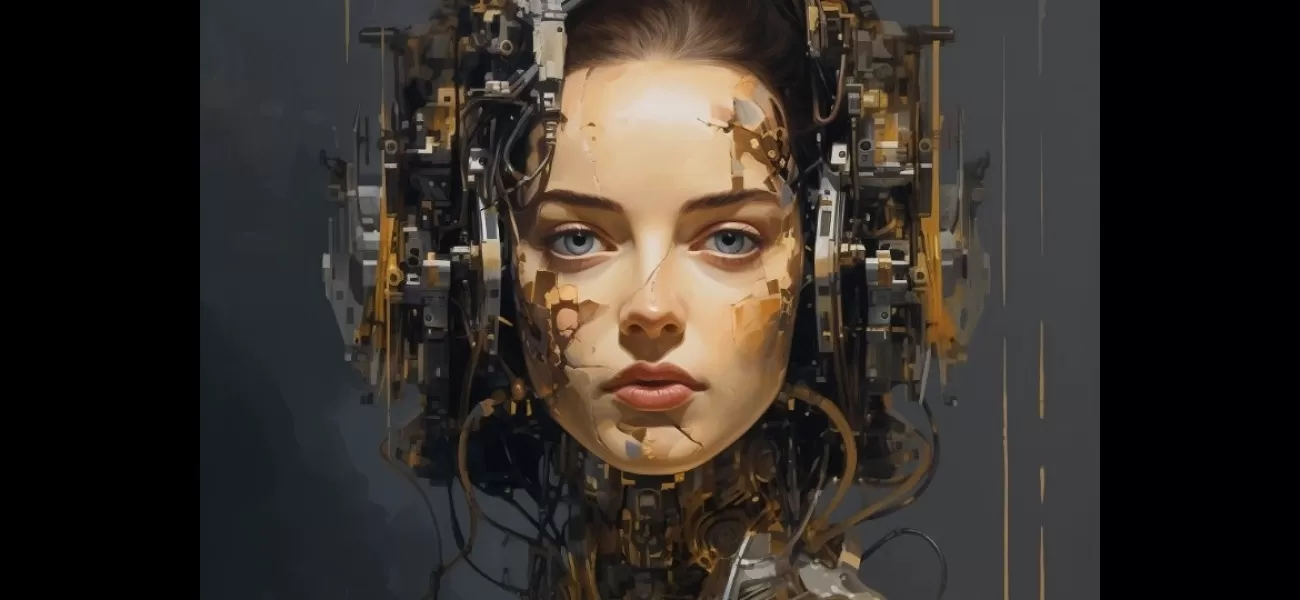Robots are becoming increasingly advanced, giving us a glimpse into a not-so-distant future. Here are 7 of the world's most famous AI robots.
Explore the potential of AI robots, and learn about the world-famous Sophia AI robot.
December 20th 2023.

Is it inevitable that we'll all have an AI robot doing our household chores in the near future?
The world of technology is changing rapidly, and AI robots are leading the way. Their potential to revolutionize our lives, work, and how we interact with the world is remarkable. From making things in factories to helping doctors in hospitals, AI robots are capable of many tasks on their own.
But what is an AI robot exactly? AI robots are designed to perform tasks or interact with humans using artificial intelligence technology. They combine physical hardware, such as sensors, motors, and manipulators, with advanced software algorithms. This allows them to learn from their experiences, adapt to different situations, and improve their performance over time.
Here are 7 of the world's most famous AI robots that you should know about.
Sophia is arguably the most famous AI robot. Developed by Hong Kong-based company Hanson Robotics, she has gained international attention for her human-like appearance and capabilities. Sophia incorporates artificial intelligence to interact with people and learn from her experiences. She has been featured in numerous media appearances and events around the world, and even became the first robot to receive citizenship in a country.
Ameca is a revolutionary humanoid robot designed to disrupt various industries. Boasting strikingly realistic facial expressions and the ability to converse naturally, it has the potential to forge genuine connections with people.
Valkyrie is NASA's groundbreaking creation, designed to tackle the most arduous challenges both on Earth and beyond. Its robust design, equipped with advanced sensors and agile manipulators, make it invaluable for space exploration and disaster response.
Nadine, a creation by Nanyang Technological University in Singapore, blends cutting-edge robotics with human-like expressions and personality. It is designed to mimic human behavior, and can engage in meaningful conversations and remember past interactions.
Jia Jia, China's humanoid robot developed by the University of Science and Technology of China, stands as a symbol of innovation in the world of robotics. With its human-like appearance and ability to hold conversations and make eye contact, it represents a significant leap in creating robots that mimic human behavior and interactions.
Finally, Grace Robot is a pioneering force in the healthcare sector. Developed by Hanson Robotics, it provides invaluable assistance and support in healthcare environments. Grace is equipped with advanced AI capabilities, enabling it to engage with patients, assist medical staff, and perform a myriad of tasks. Its lifelike expressions and natural language processing allow it to establish meaningful connections with patients, potentially improving the quality of care and easing the burden on healthcare professionals.
Clearly, the potential of AI robots is immense. They have the potential to revolutionize how we interact with the world and even provide companionship. As technology continues to evolve, who knows what possibilities AI robots will bring?
Is it inevitable that we’ll all have an AI robot doing our household chores in the near future? We are living in the world of technology where AI robots are leading the way with their incredible ability to think and learn like humans. AI robots have the potential to revolutionize our lives, work, and how we interact with the world.
From making things in factories to providing assistance in hospitals, AI robots can do a wide variety of tasks on their own. They can make processes faster, more efficient, and open up new opportunities. In this article, we’ll explore the amazing potential of AI robots and introduce you to seven of the world’s most famous AI robots.
So, what is an AI robot? An AI robot is a type of robot that is designed to perform tasks or interact with humans using artificial intelligence technology. It combines physical hardware, such as sensors, motors, and manipulators, with advanced software algorithms that enable it to perceive and understand its environment, make decisions, and take actions autonomously or with minimal human intervention. The AI component allows the robot to learn from its experiences, adapt to different situations, and improve its performance over time. AI robots can be used in various fields, such as manufacturing, healthcare, transportation, and even in our homes as personal assistants or companions.
Let’s take a look at seven of the world’s most famous AI robots. First, there’s Sophia. Arguably the most famous AI robot, Sophia is a highly advanced humanoid robot developed by Hong Kong-based company Hanson Robotics. She has gained international attention and recognition for her human-like appearance and capabilities. Sophia uses natural language processing and computer vision to understand and respond to questions and comments. She can engage in conversations, answer questions, provide information, and even make jokes. She has been programmed to understand emotions and adapt her responses accordingly. Sophia has been featured in numerous media appearances and events around the world and even became the first robot to receive citizenship in a country.
Next, there’s Ameca. Engineered Arts brings a revolutionary humanoid robot to life through Ameca. Boasting strikingly realistic facial expressions and the ability to converse naturally, Ameca embodies the next leap in human-robot interaction. Its seamless mobility allows it to navigate diverse environments autonomously, making it an ideal fit for roles in hospitality, customer service, and cutting-edge research.
Valkyrie is NASA’s groundbreaking creation for space exploration and disaster response. This humanoid robot has a robust design, equipped with advanced sensors and agile manipulators, and is designed to explore uncharted territories and handle hazardous environments. It has the potential for autonomous decision-making and dexterity, making it an invaluable asset for missions in extreme environments.
Nadine is a creation by Nanyang Technological University in Singapore. Nadine breaks barriers by blending cutting-edge robotics with human-like expressions and personality. It is designed to mimic human behavior and has the ability to converse, remember past interactions, and display emotions. Its natural language processing abilities enable it to engage in meaningful conversations.
Jia Jia is China’s groundbreaking humanoid robot developed by the University of Science and Technology of China. This marvel of technology embodies sophistication and grace, standing as a symbol of innovation in the world of robotics. Jia Jia’s human-like appearance, coupled with its ability to hold conversations and make eye contact, represents a significant leap in creating robots that mimic human behavior and interactions.
Finally, there’s Grace. Grace Robot is a pioneering force in the healthcare sector, developed by Hanson Robotics. It is equipped with advanced artificial intelligence capabilities, enabling it to engage with patients, assist medical staff, and perform a myriad of tasks to streamline healthcare operations. It is able to interact empathetically with patients, aiding in tasks such as monitoring vital signs, offering medication reminders, and providing emotional support.
It is clear that AI robots have immense potential. From providing companionship to aiding in space exploration, AI robots are changing the way we think about technology and the future. As technology evolves, AI robots are bringing us one step closer to a world where robots and humans can live together harmoniously.
The world of technology is changing rapidly, and AI robots are leading the way. Their potential to revolutionize our lives, work, and how we interact with the world is remarkable. From making things in factories to helping doctors in hospitals, AI robots are capable of many tasks on their own.
But what is an AI robot exactly? AI robots are designed to perform tasks or interact with humans using artificial intelligence technology. They combine physical hardware, such as sensors, motors, and manipulators, with advanced software algorithms. This allows them to learn from their experiences, adapt to different situations, and improve their performance over time.
Here are 7 of the world's most famous AI robots that you should know about.
Sophia is arguably the most famous AI robot. Developed by Hong Kong-based company Hanson Robotics, she has gained international attention for her human-like appearance and capabilities. Sophia incorporates artificial intelligence to interact with people and learn from her experiences. She has been featured in numerous media appearances and events around the world, and even became the first robot to receive citizenship in a country.
Ameca is a revolutionary humanoid robot designed to disrupt various industries. Boasting strikingly realistic facial expressions and the ability to converse naturally, it has the potential to forge genuine connections with people.
Valkyrie is NASA's groundbreaking creation, designed to tackle the most arduous challenges both on Earth and beyond. Its robust design, equipped with advanced sensors and agile manipulators, make it invaluable for space exploration and disaster response.
Nadine, a creation by Nanyang Technological University in Singapore, blends cutting-edge robotics with human-like expressions and personality. It is designed to mimic human behavior, and can engage in meaningful conversations and remember past interactions.
Jia Jia, China's humanoid robot developed by the University of Science and Technology of China, stands as a symbol of innovation in the world of robotics. With its human-like appearance and ability to hold conversations and make eye contact, it represents a significant leap in creating robots that mimic human behavior and interactions.
Finally, Grace Robot is a pioneering force in the healthcare sector. Developed by Hanson Robotics, it provides invaluable assistance and support in healthcare environments. Grace is equipped with advanced AI capabilities, enabling it to engage with patients, assist medical staff, and perform a myriad of tasks. Its lifelike expressions and natural language processing allow it to establish meaningful connections with patients, potentially improving the quality of care and easing the burden on healthcare professionals.
Clearly, the potential of AI robots is immense. They have the potential to revolutionize how we interact with the world and even provide companionship. As technology continues to evolve, who knows what possibilities AI robots will bring?
Is it inevitable that we’ll all have an AI robot doing our household chores in the near future? We are living in the world of technology where AI robots are leading the way with their incredible ability to think and learn like humans. AI robots have the potential to revolutionize our lives, work, and how we interact with the world.
From making things in factories to providing assistance in hospitals, AI robots can do a wide variety of tasks on their own. They can make processes faster, more efficient, and open up new opportunities. In this article, we’ll explore the amazing potential of AI robots and introduce you to seven of the world’s most famous AI robots.
So, what is an AI robot? An AI robot is a type of robot that is designed to perform tasks or interact with humans using artificial intelligence technology. It combines physical hardware, such as sensors, motors, and manipulators, with advanced software algorithms that enable it to perceive and understand its environment, make decisions, and take actions autonomously or with minimal human intervention. The AI component allows the robot to learn from its experiences, adapt to different situations, and improve its performance over time. AI robots can be used in various fields, such as manufacturing, healthcare, transportation, and even in our homes as personal assistants or companions.
Let’s take a look at seven of the world’s most famous AI robots. First, there’s Sophia. Arguably the most famous AI robot, Sophia is a highly advanced humanoid robot developed by Hong Kong-based company Hanson Robotics. She has gained international attention and recognition for her human-like appearance and capabilities. Sophia uses natural language processing and computer vision to understand and respond to questions and comments. She can engage in conversations, answer questions, provide information, and even make jokes. She has been programmed to understand emotions and adapt her responses accordingly. Sophia has been featured in numerous media appearances and events around the world and even became the first robot to receive citizenship in a country.
Next, there’s Ameca. Engineered Arts brings a revolutionary humanoid robot to life through Ameca. Boasting strikingly realistic facial expressions and the ability to converse naturally, Ameca embodies the next leap in human-robot interaction. Its seamless mobility allows it to navigate diverse environments autonomously, making it an ideal fit for roles in hospitality, customer service, and cutting-edge research.
Valkyrie is NASA’s groundbreaking creation for space exploration and disaster response. This humanoid robot has a robust design, equipped with advanced sensors and agile manipulators, and is designed to explore uncharted territories and handle hazardous environments. It has the potential for autonomous decision-making and dexterity, making it an invaluable asset for missions in extreme environments.
Nadine is a creation by Nanyang Technological University in Singapore. Nadine breaks barriers by blending cutting-edge robotics with human-like expressions and personality. It is designed to mimic human behavior and has the ability to converse, remember past interactions, and display emotions. Its natural language processing abilities enable it to engage in meaningful conversations.
Jia Jia is China’s groundbreaking humanoid robot developed by the University of Science and Technology of China. This marvel of technology embodies sophistication and grace, standing as a symbol of innovation in the world of robotics. Jia Jia’s human-like appearance, coupled with its ability to hold conversations and make eye contact, represents a significant leap in creating robots that mimic human behavior and interactions.
Finally, there’s Grace. Grace Robot is a pioneering force in the healthcare sector, developed by Hanson Robotics. It is equipped with advanced artificial intelligence capabilities, enabling it to engage with patients, assist medical staff, and perform a myriad of tasks to streamline healthcare operations. It is able to interact empathetically with patients, aiding in tasks such as monitoring vital signs, offering medication reminders, and providing emotional support.
It is clear that AI robots have immense potential. From providing companionship to aiding in space exploration, AI robots are changing the way we think about technology and the future. As technology evolves, AI robots are bringing us one step closer to a world where robots and humans can live together harmoniously.
[This article has been trending online recently and has been generated with AI. Your feed is customized.]
[Generative AI is experimental.]
0
0
Submit Comment





